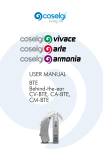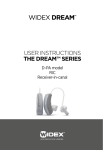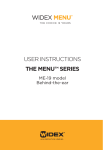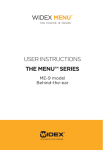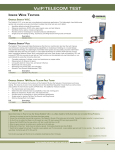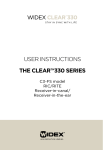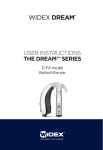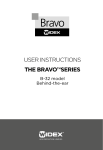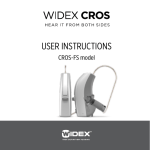Download User instrUctions The mind™440, mind™330, mind™220 SerieS
Transcript
User instructions The mind™440, mind™330, mind™220 Series m4-m/m4-m-CB/m3-m/m3-m-CB/ m2-m/m2-m-CB model Behind-the-ear your widex mind™ hearing aid (To be filled out by the hearing care professional) mind440 mind330 mind220 Date:___________________________________________ Battery size: 10 2 Programs: Master Music TV Comfort Acclimatisation Audibility Extender Zen Zen+ 3 Contents Description of the hearing aid . . . . . . . . . . . . . . . . . . . . . . . . . . . . . . . 6 Right/left identification . . . . . . . . . . . . . . . . . . . . . . . . . . . . . . . . . . . . . . . . . . . 10 Acoustic indicators . . . . . . . . . . . . . . . . . . . . . . . . . . . . . . . . . . . . . . . . . . . . . . . 11 The battery . . . . . . . . . . . . . . . . . . . . . . . . . . . . . . . . . . . . . . . . . . . . . . . . . . . . . . 12 Inserting the battery . . . . . . . . . . . . . . . . . . . . . . . . . . . . . . . . . . . . . . . . . . . 13 Removing the battery . . . . . . . . . . . . . . . . . . . . . . . . . . . . . . . . . . . . . . . . . . . 16 Battery drawer without a nail grip . . . . . . . . . . . . . . . . . . . . . . . . . . . . . . . 17 Low battery indication . . . . . . . . . . . . . . . . . . . . . . . . . . . . . . . . . . . . . . . . . 18 Turning the hearing aid on and off . . . . . . . . . . . . . . . . . . . . . . . . . . . . . . . . 19 Positioning the hearing aid . . . . . . . . . . . . . . . . . . . . . . . . . . . . . . . . . . . . . . . . 21 Removing the hearing aid . . . . . . . . . . . . . . . . . . . . . . . . . . . . . . . . . . . . . . . 23 Volume adjustment . . . . . . . . . . . . . . . . . . . . . . . . . . . . . . . . . . . . . . . . . . . . . . . 24 Listening programs . . . . . . . . . . . . . . . . . . . . . . . . . . . . . . . . . . . . . . . . . . . . . . . 26 Switching between the listening programs . . . . . . . . . . . . . . . . . . . . . . . 31 Using a telephone . . . . . . . . . . . . . . . . . . . . . . . . . . . . . . . . . . . . . . . . . . . . . . . . 32 Cleaning . . . . . . . . . . . . . . . . . . . . . . . . . . . . . . . . . . . . . . . . . . . . . . . . . . . . . . 33 The hearing aid . . . . . . . . . . . . . . . . . . . . . . . . . . . . . . . . . . . . . . . . . . . . . . . . . . 34 The microphone openings . . . . . . . . . . . . . . . . . . . . . . . . . . . . . . . . . . . . . . . 35 4 Accessories . . . . . . . . . . . . . . . . . . . . . . . . . . . . . . . . . . . . . . . . . . . . . . . . . . In case of malfunction . . . . . . . . . . . . . . . . . . . . . . . . . . . . . . . . . . . . . . Caring for your hearing aid . . . . . . . . . . . . . . . . . . . . . . . . . . . . . . . . . Warnings . . . . . . . . . . . . . . . . . . . . . . . . . . . . . . . . . . . . . . . . . . . . . . . . . . . . Advice . . . . . . . . . . . . . . . . . . . . . . . . . . . . . . . . . . . . . . . . . . . . . . . . . . . . . . . . Symbols . . . . . . . . . . . . . . . . . . . . . . . . . . . . . . . . . . . . . . . . . . . . . . . . . . . . . . 5 36 37 39 41 46 48 Description of the hearing aid Your hearing aid is used with an ear-set which consists of a tube and an ear-tip or earmould. The illustration below shows the hearing aid without an ear-set. The choice of ear-set solution depends on your specific needs. Please refer to the separate ear-set user manual. 1. Microphone openings 2. Program button (available in some versions) 3. On/off function (integrated into the battery drawer) 4. Nail grip 5. Right/Left identification 6 1 3 5 4 2 If you need help to identify the serial number (usually six or seven digits) on the product, please contact your hearing care professional. Your hearing aid may be provided with an optional listening program called Zen. It makes musical tones (and sometimes a rushing noise) in the background. These sounds are shaped according to your hearing loss. 7 NOTE In addition to these user instructions, a separate user manual is provided describing the various ear-set solutions available for your hearing aid: “Ear-sets for Widex BTE hearing aids”. WARNING This booklet and the manual “Ear-sets for Widex BTE hearing aids” contain important information and instructions. Read these booklets carefully before you start using the hearing aid. NOTE Your hearing aid, ear-set and accessories may not look exactly as illustrated in this booklet. We also reserve the right to make any changes considered necessary. 8 Intended use The hearing aids are intended as air conduction amplification devices to be used in everyday listening environments. The hearing aids may be provided with the Zen program intended to provide a relaxing sound background (i.e. music/noise source) for adults who desire to listen to such a background in quiet. Indications for use The devices are indicated for individuals with a range of hearing loss severity from minimal (10 dB HL) to severe (80 dB HL) and all hearing loss configurations. They are to be programmed by licensed hearing care professionals (audiologists, hearing aid specialists, otolaryngologists) who are trained in hearing (re) habilitation. 9 Right/left identification If you wear hearing aids on both ears, the hearing aids can be provided with coloured marks (red mark = right and blue mark = left). The arrow shows the position of the identification mark. 10 Acoustic indicators The hearing aid may be set to produce a signal to indicate the use of certain functions. The signal may be a spoken message (SmartSpeak) or tones (SmartTone). The signal can also be deactivated. Functions Default settings Other settings Adjusting volume via remote control Tone Off Confirming program button use Clicking sound Off Changing program Message Tones/off Starting up the hearing aid Message Tone/off Warning about low battery Message 4 tones/off Service reminder Off Message 11 The battery We recommend zinc-air batteries. Use a size 10 battery for the hearing aid. To obtain replacement batteries, please consult your hearing care professional. It is important to take note of the expiry date and the recommendations on the battery pack regarding disposal of used batteries. Otherwise there is a risk that the battery life may be reduced. 12 Inserting the battery Before inserting a new battery into the hearing aid, remember to remove the adhesive tab. Once the tab has been removed, the battery will start functioning after a few seconds. CAUTION Do not use batteries if there is a sticky residue from the tab or other unwanted substance, as this can cause the hearing aid to malfunction. 13 Use the nail grip to gently swing the battery drawer open. Do not press the drawer beyond the open position. 14 Place the battery in the drawer as illustrated, so that the plus (+) sign on the battery is facing towards you when you hold the hearing aid as shown. You can use the battery magnet provided to steer the battery into place. If the battery drawer does not close easily, the battery is incorrectly inserted. When changing battery, it is a good idea to hold the hearing aid over a table. 15 Removing the battery 1.Open the battery drawer as previously described. Place the hearing aid on the provided cloth on a clean, plane surface and turn it as illustrated. 2.Supporting the drawer with your finger, use the battery magnet provided to push the battery out of the battery drawer from the minus side. 1 2 16 Battery drawer without a nail grip The hearing aid may be provided with a battery drawer without a nail grip, which means that you need a tool to open the battery drawer. This type of drawer can be a good choice if the hearing aid is worn by a child. A special tool for opening the drawer will be included with this drawer. The battery drawer is opened as illustrated. 17 Low battery indication An acoustic indicator will sound when the battery is nearly exhausted, unless this function has been disabled (see page 11). We recommend that you always have a spare battery with you. WARNING Never leave an exhausted battery in the hearing aid. Exhausted batteries may leak, damaging the hearing aid. WARNING Your hearing aid may stop functioning, for instance if the battery is exhausted. You should be aware of this possibility, in particular when you are in traffic or are otherwise dependent on warning signals. 18 Turning the hearing aid on and off The battery drawer of the hearing aid also functions as the on/ off switch. Close the battery drawer to turn on the hearing aid. An acoustic indicator will indicate that the hearing aid has been switched on unless this function has been disabled. 19 Open the battery drawer completely to turn off the hearing aid. Please remember to turn off the hearing aid when it is not in use. Remove the battery if the hearing aid will not be used for several days. 20 Positioning the hearing aid Insert the earpiece in the ear canal while holding the lower part of the tube. It may help to pull the outer ear backwards and upwards with the opposite hand. Place the hearing aid behind the ear, so that the hearing aid and tube rest comfortably on the ear, close to your head. 21 The illustrations show an open ear-tip. For further information on ear-tip/earmould types, anchors and procedures, see the separate ear-set user manual provided. If the ear-set does not fit or sit properly, causing discomfort, irritation, redness or the like, contact your hearing care professional. 22 Removing the hearing aid Remove the hearing aid from its position behind the ear. Carefully pull the earpiece out of the ear canal, while holding the lower part of the tube. If the earpiece is provided with an extraction cord, take hold of this and carefully pull the earpiece out of the ear canal. 23 Volume adjustment The hearing aid volume is adjusted automatically in accordance with your sound environment. If you have a remote control, you can also adjust the volume manually or mute your hearing aid. Any adjustment of the volume setting will be cancelled when your hearing aid is turned off, or when you change program. If you have a remote control, please also refer to the user instructions for this. 24 WARNING If the volume in the hearing aid is generally too loud or too weak, or the reproduced sounds are distorted, or if you would like any further information, consult your hearing care professional. To mute the hearing aid with a remote control: Keep pressing the volume down key on the remote control after the long beep-tone has sounded and until it stops. Pressing one of the volume keys briefly will bring back the sound. 25 Listening programs Your hearing aid may be provided with several of the following programs, plus the special Zen program called Zen+. Master Standard Music For listening to music TV For listening to the TV Comfort Attenuates background noise. Acclimatisation This program has the same features as the Master program but provides slightly less amplification Audibility Extender Makes high-frequency sounds audible 26 Zen Generates different kinds of tones or noise Zen+ Special Zen program with up to three different Zen styles If your needs change over time, the combination of listening programs can be altered. 27 Zen program Your hearing aid may be provided with a unique optional listening program called Zen. It makes musical tones (and sometimes a rushing noise) in the background. These sounds are shaped according to your hearing loss. The Zen program may be used alone (without amplification) in quiet when you are not required to hear surrounding sounds. Or, it may be used with amplification so that both the surrounding sounds and the generated sounds (fractal tones and noise) are heard together. 28 caution Use of the different Zen programs may interfere with hearing surrounding sounds including speech. The programs should not be used when hearing such sounds is important. Switch the hearing aid to a non-Zen program in those situations. CAUTION If you perceive a decrease in loudness, tolerance of sounds, speech not as clear, or worsening tinnitus, contact your hearing care professional. 29 Benefits The Zen program may provide a relaxing listening background for some people. When the Zen program is used in a tinnitus management program, its wearer may experience some relief from tinnitus. Indications for use The Zen program is intended to provide a relaxing sound background (i.e., music/noise source) for adults who desire to listen to such a background in quiet. It may be used as a sound therapy tool in a tinnitus treatment program that is prescribed by a hearing care professional (audiologists, hearing aid specialists, otolaryngologists) who is trained in tinnitus management. Directions for use Because of the unique ways in which Zen is programmed in your hearing aid, please follow the recommendations of your hearing care professionals as to how to use the program, when to use the program and/or how long to use the program. 30 Switching between the listening programs To change programs, press the program button (if available) on the hearing aid or the remote control briefly. Each time you change program an acoustic indicator will sound unless this function has been disabled. Program 1: Program 2: Program 3: Program 4: Program 5: Zen+: Message or one short beep Message or two short beeps Message or three short beeps Message or one long and one short beep Message or one long and two short beeps Message or tone Zen+ This program is accessed via a long press (more than 1 second) on the program button of the hearing aid or remote control. A short press then allows you to cycle through the available Zen styles. You can exit Zen+ by pressing and holding the program button for more than 1 second. 31 Using a telephone When using a telephone, we recommend that you hold the telephone against your head at an angle above your ear, rather than directly against the ear. If the sound is not optimal, try moving the telephone earpiece to a slightly different position. 32 Cleaning The following cleaning accessories are available for the hearing aid and ear-set *. For cleaning the ear-set, see the user manual “Ear-sets for Widex BTE hearing aids”. 1.Cloth 2.Wax removing tool 3.Cleaning thread Contact your hearing care professional if you need additional supplies of cleaning accessories. * Selection depends on ear-set type 33 The hearing aid Clean the hearing aid with the soft cloth after use. Warning Never use water or cleaning solutions to clean the hearing aid, as this may cause it to malfunction. 34 The microphone openings Clean the microphone openings by passing the wax removing tool straight through the openings. If you feel resistance, withdraw the tool and try again. Use only the wax removing tool provided. If the microphone openings are still blocked, contact your hearing care professional. When the hearing aid is not in use, keep it in a warm, dry place with the battery drawer open, to ventilate the hearing aid and allow it to dry. 35 Accessories Remote control Some hearing aids of the model you have may be provided with a remote control. These hearing aids have no program button. If your hearing aid has a remote control, please also refer to the user instructions for this. 36 In case of malfunction Problem Possible cause The hearing aid is The hearing aid is not completely silent turned on The hearing aid volume is not powerful enough Solution Make sure the battery drawer is closed The battery does not work Insert a new battery in the battery drawer The battery is nearly exhausted Insert a new battery in the battery drawer Your ear is blocked by earwax Contact your ENT doctor/ physician Your hearing may have Contact your hearing care changed professional 37 Problem Possible cause Solution The hearing aid whistles continuously Your ear is blocked by earwax Contact your ENT doctor/ physician Note: This information covers only the hearing aid. See the “Earsets for Widex BTE hearing aids” user manual for information specific to your ear-set. If the problems persist, contact your hearing care professional for assistance. 38 Caring for your hearing aid The hearing aid is a valuable object and should be treated with care. Here are some things you can do to prolong the life of your hearing aid: 39 CAUTION • Turn off your hearing aid when it is not in use. Remove the battery if the hearing aid will not be used for several days. • When the hearing aid is not in use, keep it in its case in a dry location out of reach of children and pets. • Do not expose the hearing aid to extreme temperatures or high humidity. Make sure to dry the hearing aid thoroughly after heavy perspiration such as that which may occur during intense physical activity, e.g. playing sports. • Avoid dropping your hearing aid – perform cleaning and battery changes while holding the hearing aid above a soft surface. • Do not wear your hearing aid while in the shower or swimming, or when using a hair dryer, perfume, hair and body sprays or gels such as suntanning lotions or creams. 40 Warnings WARNING Hearing aids and batteries can be dangerous if swallowed or used improperly. Swallowing or improper use can result in s evere injury or even fatalities. In case of ingestion, contact a physician immediately. • Keep hearing aids and their parts, accessories and batteries out of reach of children and anyone else who might swallow such items or otherwise cause injury to themselves. Do not change batteries in front of them and do not let them see where you keep your battery supply. Discard used batteries carefully. • Batteries are very small and can easily be mistaken for pills or the like. Never put a battery or hearing aid in your mouth for any reason as you may risk swallowing it. 41 • Clean and inspect your hearing aid after use to check that it is intact. If the hearing aid or the ear-set breaks while in the ear canal, contact your hearing care professional immediately. Do not try to remove the parts yourself. warning • Risk of explosion if battery is replaced by an incorrect type or recharged. Dispose of used batteries according to the instructions. • Never allow others to wear your hearing aid, as this could cause permanent damage to their hearing. • When selecting a listening program, please remember that there are situations in which it is particularly important to be able to hear the surrounding sounds (e.g. traffic, warning signals). • The hearing aid is made of modern non-allergenic materials. Nonetheless, in rare cases skin irritation may occur. If you notice skin irritation in or around your ear or ear canal, contact your hearing care professional. 42 warning • Please note that when using any type of hearing aid, you must allow regular ventilation of the ear. If the ear is not adequately ventilated, there may be a slightly increased risk of infection or disease in the ear canal. We therefore recommend that you remove the hearing aid and ear-set from your ear when you go to bed, to allow the ear canal to be ventilated. If possible, you should also remove your hearing aid and ear-set during the day if there are any periods when you do not need them. Make sure that you clean and inspect your hearing aid and ear-set as required. If an ear infection or disease occurs, you should seek medical attention and contact your hearing care professional for advice on how to disinfect the various hearing aid parts. Do not under any circumstances use alcohol, chlorine or similar substances for this purpose. • Regular use of a de-humidifier is recommended to help avoid malfunction of the hearing aid. 43 • Do not use Widex hearing aids in mines or other areas with explosive gases. • Do not wear your hearing aid during radiation, X-rays, MRIs, CT or other medical treatments and scans. The emissions from these procedures as well as from other types of radiation, such as that in a microwave oven, can damage your hearing aid and the hearing aid can become very hot. Radiation from, for example, room surveillance equipment, burglar alarms and mobile phones is weaker and will not damage the hearing aid, but may create audible interference. 44 CAUTION • Your hearing aid has been tested for interference according to international standards. Nevertheless, it is possible that unforeseen interference may occur in the hearing aid due to electromagnetic radiation from other products such as alarm systems, room surveillance equipment and mobile phones. • Although your hearing aid has been designed to comply with the most stringent international electromagnetic compatibility standards, the possibility cannot be excluded that it may cause interference with other equipment, such as medical devices. • Never try to open or repair the hearing aid yourself. 45 Advice NOTE • The hearing aid will not restore normal hearing and will not prevent or improve a hearing loss resulting from organic conditions. However, the hearing aid can help you to make the best possible use of your remaining hearing ability. You should also bear in mind that it can take time to get used to a new hearing aid and new sounds. • In most cases, using the hearing aid infrequently will not permit you to gain full benefit from it. • The use of a hearing aid is only part of hearing habilitation and may need to be supplemented by auditory training and instruction in lipreading. • The use of hearing aids increases the risk of accumulation of earwax. Contact your physician/ENT doctor if you suspect that a plug of earwax has accumulated in your ear. Earwax may not only reduce your own hearing but also the effect of the hearing aid considerably. It is a good idea to ask your physician to clean your ears a couple of times a year. 46 Electrical and electronic equipment (EEE) contains materials, components and substances that can be hazardous and present a risk to human health and the environment when waste electrical and electronic equipment (WEEE) is not handled correctly. Do not dispose of hearing aids, hearing aid accessories and batteries with ordinary household waste. Hearing aids, batteries and hearing aid accessories should be disposed of at sites intended for waste electrical and electronic equipment, or given to your hearing care professional for safe disposal. Proper disposal helps to protect human health and the environment. 47 Symbols symbols commonly used by widex a/s in medical device labelling (labels/ifu/etc .) symbol Title/description manufacturer the product is produced by the manufacturer whose name and address are stated next to the symbol . if appropriate, the date of manufacture may also be stated . date of manufacture the date when the product was manufactured . use-by date the date after which the product is not to be used . Batch code the product’s batch code (lot or batch identification) . 48 symbol Title/description Catalogue number the product’s catalogue (item) number . serial number the product’s serial number .* Keep away from sunlight the product must be protected from light sources and/or the product must be kept away from heat Keep dry the product must be protected from moisture and/or the product must be kept away from rain lower limit of temperature the lowest temperature to which the product can be safely exposed . 49 symbol Title/description upper limit of temperature the highest temperature to which the product can be safely exposed . Temperature limits the highest and lowest temperatures to which the product can be safely exposed . Consult instructions for use the user instructions contain important cautionary information (warnings/precautions) and must be read before using the product . Caution/warning text marked with a caution/warning symbol must be read before using the product . 50 symbol Title/description weee mark “not for general waste” When the product is to be discarded, it must be sent to a designated collection point for recycling and recovery . Ce mark the product is in conformity with the requirements set out in european ce marking directives . alert the product is identified by r&tte Directive 1999/5/ec as an equipment class 2 product with some restrictions on use in some ce member states . C-Tick mark the product complies with eMc and radio spectrum regulatory requirements for products supplied to the Australian or new Zealand market . 51 symbol Title/description interference electromagnetic interference may occur in the vicinity of the product . *the six- or seven-digit number on the product is the serial number . serial numbers may not always be preceded by 52 53 54 55 WIDEX A/S Nymoellevej 6, DK-3540 Lynge, Denmark www.widex.com Manual no.: 9 514 0272 001 #02 Issue: 2015-06 WIDEX and MIND are trademarks of Widex A/S É[5qr0w7|s;;a;d]

































































